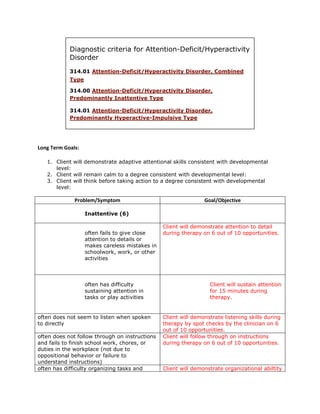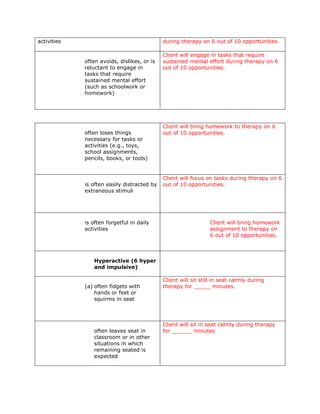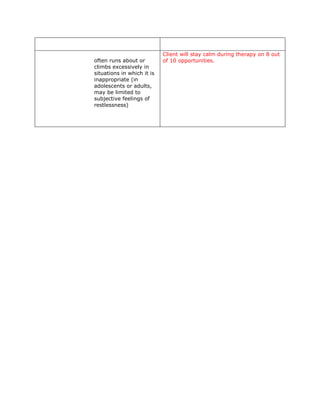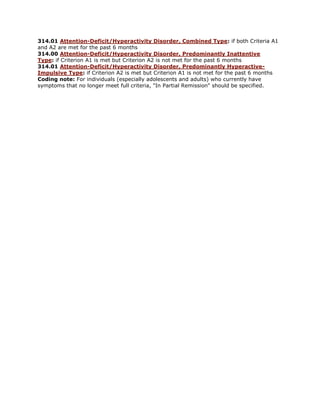Adhd symptoms and_goals
- 1. Diagnostic criteria for Attention-Deficit/Hyperactivity Disorder 314.01 Attention-Deficit/Hyperactivity Disorder, Combined Type 314.00 Attention-Deficit/Hyperactivity Disorder, Predominantly Inattentive Type 314.01 Attention-Deficit/Hyperactivity Disorder, Predominantly Hyperactive-Impulsive Type Long Term Goals: 1. Client will demonstrate adaptive attentional skills consistent with developmental level: 2. Client will remain calm to a degree consistent with developmental level: 3. Client will think before taking action to a degree consistent with developmental level: Problem/Symptom Goal/Objective Inattentive (6) Client will demonstrate attention to detail often fails to give close during therapy on 6 out of 10 opportunities. attention to details or makes careless mistakes in schoolwork, work, or other activities often has difficulty Client will sustain attention sustaining attention in for 15 minutes during tasks or play activities therapy. often does not seem to listen when spoken Client will demonstrate listening skills during to directly therapy by spot checks by the clinician on 6 out of 10 opportunities. often does not follow through on instructions Client will follow through on instructions and fails to finish school work, chores, or during therapy on 6 out of 10 opportunities. duties in the workplace (not due to oppositional behavior or failure to understand instructions) often has difficulty organizing tasks and Client will demonstrate organizational abiltity
- 2. activities during therapy on 6 out of 10 opportunities. Client will engage in tasks that require often avoids, dislikes, or is sustained mental effort during therapy on 6 reluctant to engage in out of 10 opportunities. tasks that require sustained mental effort (such as schoolwork or homework) Client will bring homework to therapy on 6 often loses things out of 10 opportunities. necessary for tasks or activities (e.g., toys, school assignments, pencils, books, or tools) Client will focus on tasks during therapy on 6 is often easily distracted by out of 10 opportunities. extraneous stimuli is often forgetful in daily Client will bring homework activities assignment to therapy on 6 out of 10 opportunities. Hyperactive (6 hyper and impulsive) Client will sit still in seat calmly during (a) often fidgets with therapy for _____ minutes. hands or feet or squirms in seat Client will sit in seat calmly during therapy often leaves seat in for ______ minutes classroom or in other situations in which remaining seated is expected
- 3. Client will stay calm during therapy on 8 out often runs about or of 10 opportunities. climbs excessively in situations in which it is inappropriate (in adolescents or adults, may be limited to subjective feelings of restlessness)
- 4. Client will play games calmly during therapy often has difficulty on 8 out of 10 opportunities playing or engaging in leisure activities quietly Client will remain clam during therapy on 8 is often "on the go" or out of 10 opportunities. often acts as if "driven by a motor" often talks excessively Client will engage in reciprocal conversation during therapy on 8 out of 10 sessions. Impulsivity Client will wait until question has been asked often blurts out answers before answering during therapy on 8 out of before questions have 10 opportunities. been completed Client will wait for turn while playing games ) often has difficulty during therapy on 8 out of 10 awaiting turn opportunities. often interrupts or intrudes Client will wait for the on others (e.g., butts into clinician to stop talking conversations or games) before speaking during therapy on 8 out of 10 opportunities. Code based on type:
- 5. 314.01 Attention-Deficit/Hyperactivity Disorder, Combined Type: if both Criteria A1 and A2 are met for the past 6 months 314.00 Attention-Deficit/Hyperactivity Disorder, Predominantly Inattentive Type: if Criterion A1 is met but Criterion A2 is not met for the past 6 months 314.01 Attention-Deficit/Hyperactivity Disorder, Predominantly Hyperactive- Impulsive Type: if Criterion A2 is met but Criterion A1 is not met for the past 6 months Coding note: For individuals (especially adolescents and adults) who currently have symptoms that no longer meet full criteria, "In Partial Remission" should be specified.




